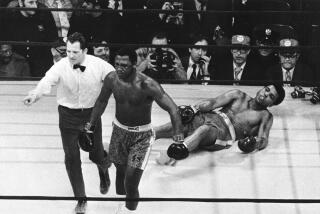COMMENTARY : Look at Tape Doesn’t End Questions : Boxing: ‘Phantom punch’ still doesn’t seem to have had enough zip to put away Liston.
- Share via
A frame-by-frame videotape replay of Ali-Liston II shows clearly that Sonny Liston was struck by Muhammad Ali’s right hand when Liston tumbled to the canvas in the fight’s first round.
But whether or not the punch was a legitimate knockout blow is much less certain. Viewed today by anyone who has seen numerous boxers knocked out, two conclusions are inescapable:
--Ali doesn’t seem to be positioned well enough to deliver a significant blow to a man who, until that night, had never been knocked off his feet. Ali is upright, on his toes, and may be been moving slightly backward when he throws the punch. It looks like a harmless arm punch, and there is no follow-through. Moreover, the intent of the punch seems to be solely to ward off the advancing Liston, to be more bothersome than concussive.
--There is something unreal, something suspicious, about Liston’s manner while on the floor. No one can say he looks like a man taking a dive, but he doesn’t look like a man who has been truly hurt, either.
The controversial ending unfolds in a neutral corner, where Liston has pursued Ali. As Liston delivers a long left jab, he takes an extraordinarily long step forward with his left foot, from 3 1/2 to 4 feet. As the jab approaches, Ali is seen solidly planting his right rear foot preparatory to throwing a counterpunch.
Liston’s jab barely grazes the bottom of Ali’s chin as Ali begins a countering right over Liston’s extended left arm. The punch appears to clip Liston on the jaw, and his head jerks downward.
Also at impact, Liston’s left foot jerks upward, about six inches off the floor, lending credence to the argument that the punch carried more impact than it seemed.
Liston falls the canvas, then rolls over slowly on his back. Ali stands over him, taunting. At this point, control of the fight slips away from the referee, Joe Walcott. Ali continues taunting his fallen foe and refuses to go to the neutral corner, as directed by Walcott. Ali actually grapples with Walcott when the referee tries to physically haul him away from Liston.
As Walcott finally steers Ali to the neutral corner, Liston rises to one knee, then falls over on his back.
Ali, meanwhile, remains in the neutral corner for about one second. Then he runs a raised-fists victory lap around the ring, finishing it off with a joyous leap into the air. By now, Liston is finally on his feet, and Walcott holds his gloves and looks to the ringside timekeepers.
Confused still, Walcott leaves the fighters and crosses the ring to confer with the timekeeper, but it is Ring magazine editor Nat Fleischer who informs Walcott that Liston had been down for more than 10 seconds--it was about 17 seconds--and that the fight is over.
And so it is. Walcott returns to the participants to find them throwing punches at each other. He pulls Ali aside and raises his arm.
The adage that pro boxing is the world’s most poorly officiated sport was never more true than on this night. At the moment the chaos begins, Walcott did nothing right. But then, neither did Ali or the timekeeper.
Walcott, who had the authority to disqualify Ali for refusing to go to the neutral corner, instead chose to wrestle with him. Finally, he simply gave up. When it was over, timekeeper Russell D. Carroll announced the time of the knockout at one minute of the first round. But shortly afterward, on video replay, it was shown the fight lasted 1 minute 54 seconds.
More to Read
Go beyond the scoreboard
Get the latest on L.A.'s teams in the daily Sports Report newsletter.
You may occasionally receive promotional content from the Los Angeles Times.










